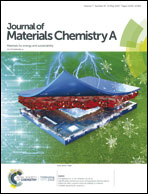A novel two-stage hybrid processing technique towards industrial manufacturing of the Cu(In,Ga)(S,Se)2 solar cell with materially efficient fabrication
Abstract
The chalcogenide Cu(In,Ga)(S,Se)2 (CIGSSe) solar cell is very promising because it exhibits one of the highest efficiencies among all thin-film solar cells. However, the expensive and complicated fabrication of these solar cells should be overcome for their successful commercialization. Herein, we investigated a novel fabrication technique that combined both vacuum and non-vacuum processes to minimize the production costs and increase the energy conversion efficiency. A carbon-free CuS nanoparticle precursor was used in the non-vacuum process to save Cu materials and the thermal budget. An (In,Ga)2Se3 precursor was formed via vacuum co-evaporation, which provided control over the stoichiometry. The CIGSSe films were fabricated using two different approaches: (1) CuS was deposited on a Mo film, with subsequent co-evaporation of the (In,Ga)2Se3 film (hybrid staking A – HSA) and (2) (In,Ga)2Se3 was deposited on a Mo film, and then, CuS was formed on top of this with selenization (hybrid stacking B – HSB). The HSA solar cells had a higher quality structure and composition when compared with the HSB cells. The HSA CIGSSe solar cell exhibited the superior energy conversion efficiency of 13.6%. Our novel fabrication technique will contribute to the widespread commercialization of CIGSSe solar cells while minimizing material consumption.



 Please wait while we load your content...
Please wait while we load your content...